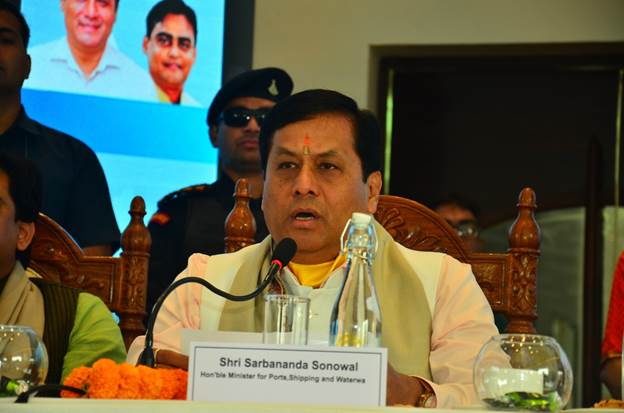
IWAI set to spark with 300-400 electric vessels in next 5 years : Sarbananda Sonowal
NEW DELHI : India’s Ministry of Ports, Shipping and Waterways (MoPSW) will invest ₹45,000 crore for the development of river cruise tourism in the country.
According to Union Minister Shri Sarbananda Sonowal, ₹35,000 crore of this allocation has been earmarked for cruise vessels, while ₹10,000 crore will be invested for the development of cruise terminal infrastructure by 2047.
Following the maiden Inland Waterways Development Council (IWDC) meeting held recently, Sonowal discussed the adoption of electric propulsion in boats, exploration of river cruises along Indo-Bangladesh protocol routes, and the facilitation of cargo movement through inland waterways in a conversation.
Q.With river traffic moving up, will there be a push towards using use of electric propulsion driven boats?
Electric propulsion led inland vessels are plying on National Waterways-3 (in and around Kochi) since April 2023. Some 12 electric Catamaran boats with passenger carrying capacity of 50 sitting and 50 standing have been deployed. Another 66 vessels shall be deployed in Kochi Water Metro within a year.
The Inland Waterways Authoirty of India (IWAI) is procuring eight Catamaran vessels, two each for Ayodhya, Varanasi, Mathura and Guwahati. Two of these, MV Guh and MV Nishadra, are on their way to Ayodhya and Varanasi.
Q.What sort of fleet expansion or replacement is being planned in green drive?
The MoPSW aims to have at least 1000 vessels based on-green fuel (including electric and green hydrogen) within the next decade. We are gradually working towards having 100 per cent of vessels powered through green fuel by 2047. Over the next 5 years, MoPSW will have about 300 to 400 electric vessels plying on inland waterways.
Q.How have river cruises along the India –Bangladesh route fared?
On January 13, the Prime Minister flagged off world’s longest river cruise MV Ganga Vilas – that sailed for 3200 km from Varanasi to Dibrugarh, using the Indo-Bangladesh route. The voyage has been so successful, that the service is already booked in advance for the next five to seven years. The PM’s vision has put us on the global river tourism map.
The first river cruise vessel along IBP was flagged in March 2019 when Indian private vessels RV Bengal Ganga traveled from Kolkata to Dhaka and Bangladeshi vessel MV Madhumoti travelled from Dhaka to Kolkata. The MoU of passengers and cruise services on coastal and Indo Bangladesh Protocol (IBP) routes was signed in April 2017. And the Standard Operating Protocol for the same was signed between India and Bangladesh in October, 2018.
The river cruise tourism was disturbed due to Covid-19 during 2020-21.
Till now, ten river cruise movements have happened on IBP route. The active route for river cruise tourism is from Kolkata, Dhaka, Guwahati, Neamati (Majuli Island) and Dibrugarh (Protocol Routes 1 & 2).
Q.What sort of investments are being made to accommodate river cruises?
Investment in river cruise tourism is of two types: creation of infrastructure taken care of by the IWAI or MoPSW; and the second – which is procurement of vessels is taken care of by private entrepreneurs. I
The infra include setting up of river cruise terminals, fairway, aids to navigation, pilotage, assistance to the cruise vessels in distress while plying on NW, coordination with State governments, etc.
The IWAI is developing 60 community jetties on NW-1 which will also be utilised for river cruise vessels. There are five dedicated river cruise jetties on NW-2 along Dibrugarh, Neamati, Biswanath Ghat, Pandu and Jogighopa. Another 10 jetties and floating terminals have already been in place on NW-2 to be used by river cruise vessels.
Q.Inland cargo movement saw an 8 per cent growth in 2023 (April – Nov). What is the growth forecast for 2024?
The last decade saw higher investment and policy reforms undertaken by Prime Minister Narendra Modi. And led to sustained revival of our traditional waterways. We have seen a five-fold increase in the cargo on national waterways, from 18.07 million tonne per annum (MTPA) in 2014 to 108.88 MTPA in 2023. The cargo movement on National Waterways is expected to increase by 10 – 12 per cent in FY24.
The cargo movement on National Waterways from April to December 2023 has shown a growth of 9 per cent as compared to the cargo movement for the same period of the previous year.
We are progressing well, and I’m confident that we will exceed the Maritime India Vision 2030 target of 200 mt and Maritime Amrit Kaal Vision 2047 target of 500 mt of cargo movement through NW.
Q.Any specific investments oninland waterways route?
There are 111 (including five existing and 106 new) National Waterways spread over 24 States. The feasibility studies of new National Waterways have been completed, and subsequent DPRs have also been completed on selected waterways.
An action plan has been formulated to develop the 26 most viable waterways. A total fund of ₹5911 crore has been allocated for capacity augmentation of existing and new waterways, development and jetties to improve the navigation facilities in the country, etc.
The Ro-Ro / Ro-Pax Service commenced on various routes, revision of levy and collection of fees of waterways user charges, enhanced regional trade with Bangladesh using IWT mode and implementation of Arth Ganga programme will impact the overall ecosystem.
Also identified on a priority basis are National Waterways in Maharashtra and Odisha. These are to be developed in a PPP mode to increase cargo movement. These include (Amba River(NW-10), Dabhol creek / Vashishti river (NW-28), Vasai creek and Ulhas river (NW-53) and Shastri river-Jaigad creek (NW-91) in Maharashtra and Brahmani – Kharsua River (NW-5) and Mahanadi River (NW-64) in Odisha. The project will require ₹15,000 – 17,000 crore through budgetary grants and PPP for works like navigational locks, fairway development, and terminals.

